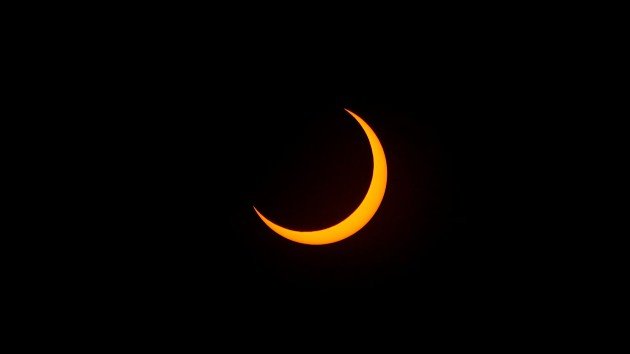WMEX Boston
Listeners:
Top listeners:
-
 play_arrow
play_arrow
WMEX WMEX Boston
-
 play_arrow
play_arrow
Courage To Hope-Episode 82-Michael Courage To Hope-Episode 82-Michael
Missing totality? April 8 partial solar eclipse times and magnitudes across the US
todayApril 4, 2024

A partial solar eclipse is seen in San Salvador, El Salvador, Oct. 14, 2023. (SOPA Images/LightRocket via Getty Images)
(NEW YORK) — Excitement is mounting for one of nature’s most unique spectacles, the total solar eclipse, set to cast a historic shadow across a path through the United States on April 8, 2024.
The track of the moon’s shadow across Earth’s surface is called the path of totality, and to witness the April 8 total solar eclipse in totality, viewers must be within the 115-mile-wide path.
But for anyone outside the path of totality, eclipse day will still offer a celestial spectacle worth getting eclipse glasses for.
“The entire contiguous United States, Hawaii and Alaska will see at least a partial eclipse,” Michael Zeiler, expert solar eclipse cartographer and founder of Greatamericaneclipse.com, told ABC News. “The closer you are to the path of totality, of course, the deeper the eclipse will be.”
To discover when to see the solar eclipse in totality or the partial eclipse in locations across the U.S. outside of the path, check out NASA’s Eclipse Explorer tool.
What is the difference between a total and partial solar eclipse?
A total solar eclipse occurs when the moon passes between the sun and the Earth and, for a short time, completely blocks the face of the sun, according to NASA.
A partial solar eclipse happens when the moon passes between the sun and Earth, but the celestial bodies are not completely aligned, according to the agency.
During a partial solar eclipse, the sun appears to be a crescent shape, according to NASA.
“The difference between a total and a partial solar eclipse is literally night and day,” Zeiler said, adding that unless you are within the path of totality, the chance to see the sun’s corona disappears.
“Even if you stand just a little bit outside the path of totality, even if you are in the zone of 99%, the sunlight is still 10,000 times brighter than the Sun’s corona,” Zeiler said. “So it’s impossible to see the corona unless you are truly inside the path of totality.”
Despite missing the total solar eclipse, Zeiler encourages all Americans to “step outside” on eclipse day.
“Enjoy the spectacle of the partial eclipse,” Zeiler said. “Because that’s still very interesting and brings you closer to the movements of the sun and moon — seeing the solar system in motion.”
Using Los Angeles, California, as an example, during the maximum of the partial solar eclipse, at 11:12 a.m., local time, 58% of the sun will be occulted by the moon.
“So it’ll be noticeably dimmer than normal, but not exceptionally,” Zeiler said, adding, “In fact, you might not even realize that an eclipse is happening unless you are paying attention to it.”
Partial solar eclipse path, magnitude and time in the US
Below is a list of some American cities where the April 8 partial solar eclipse will be most visible — pending weather forecasts — the magnitude of the eclipse in those locations and what time, locally, the partial eclipse view will be at maximum, according to Space.com.
The magnitude is the fraction of the sun’s diameter covered by the moon during the partial eclipse.
Atlanta, Georgia: 3:04 p.m., 0.846 magnitudeBoston, Massachusetts: 3:29 p.m., 0.931 magnitudeChicago, Illinois: 2:07 p.m., 0.942 magnitudeCincinnati, Ohio: 3:09 p.m., 0.993 magnitudeDenver, Colorado: 12:40 p.m., 0.715 magnitudeHelena, Montana: 12:40 p.m., 0.474 magnitudeHonolulu, Hawaii: 7:12 a.m., 0.286 magnitudeHouston, Texas: 1:40 p.m., 0.943 magnitudeJuneau, Alaska: 10:33 a.m., 0.064 magnitudeLos Angeles, California: 11:12 a.m., 0.58 magnitudeMiami, Florida: 3:01 p.m., 0.556 magnitudeNew Orleans, Lousiana: 1:49 p.m., 0.844 magnitudeNew York City, New York: 3:25 p.m., 0.91 magnitudeSeattle, Washington: 11:29 a.m., 0.311 magnitudeSt. Louis, Missouri: 2:00 p.m., 0.988 magnitudeTucson, Arizona: 11:19 a.m., 0.749 magnitudeWashington, D.C.: 3:20 p.m., 0.89 magnitude
Total solar eclipse live stream
For those outside of the path of totality, NASA will be streaming the view of the total solar eclipse live on April 8, 2024.
“Tune in for live views from across the path, expert commentary, live demos, and more,” according to the agency’s official broadcast.
Copyright © 2024, ABC Audio. All rights reserved.
Similar posts
CONTACTS
- https://wmexboston.com
- 781-834-WMEX(9639)
- studio@wmexboston.com
- 130 Enterprise Dr, Marshfield, MA 02171
ABOUT
WMEX Boston can be heard at 1510 AM, and 101.1 FM. Playing the greatest hits from 50s, 60s, 70s, 80s, and more!
MENU
SPONSORS
Copyright 2024 WMEX Boston - Design by Pro Radio Solutions





